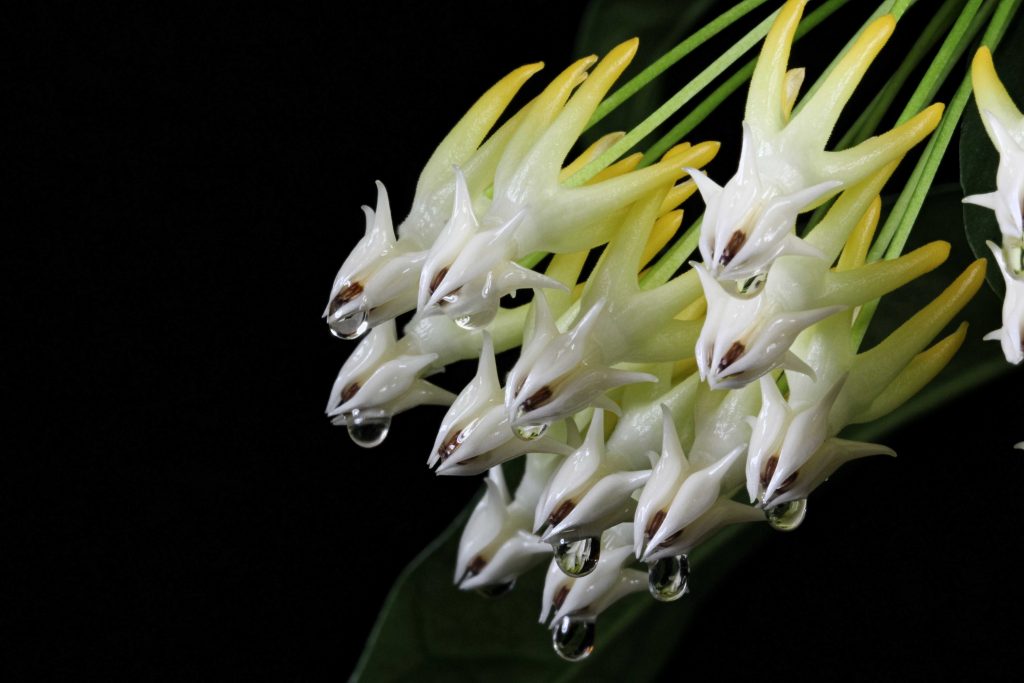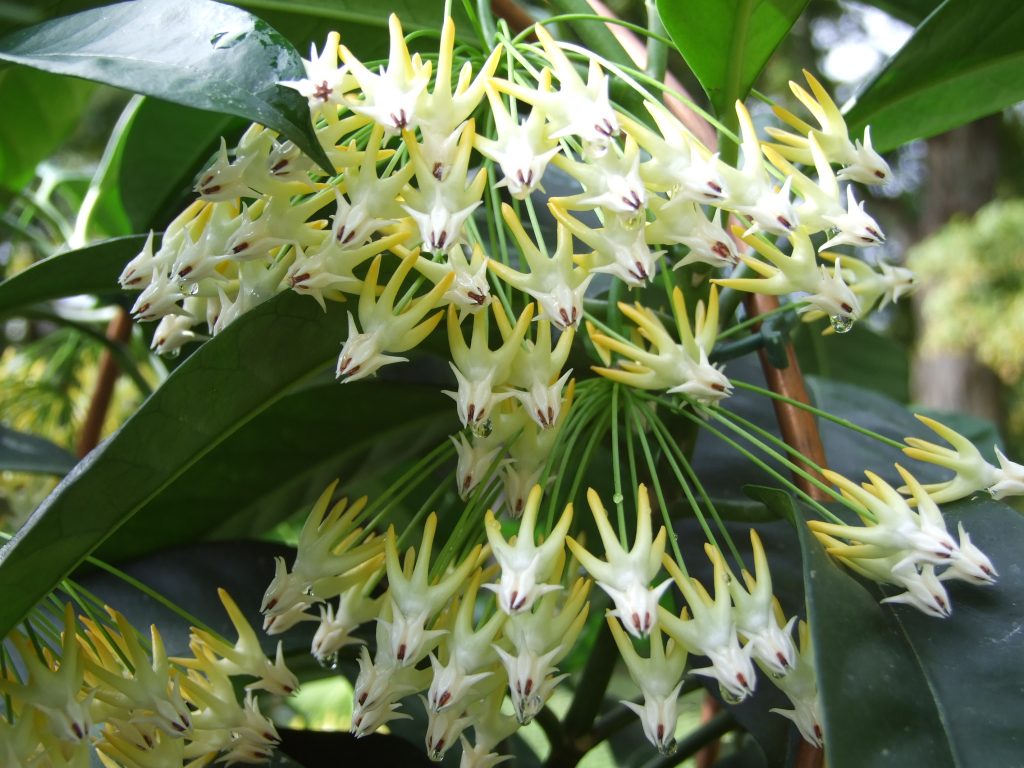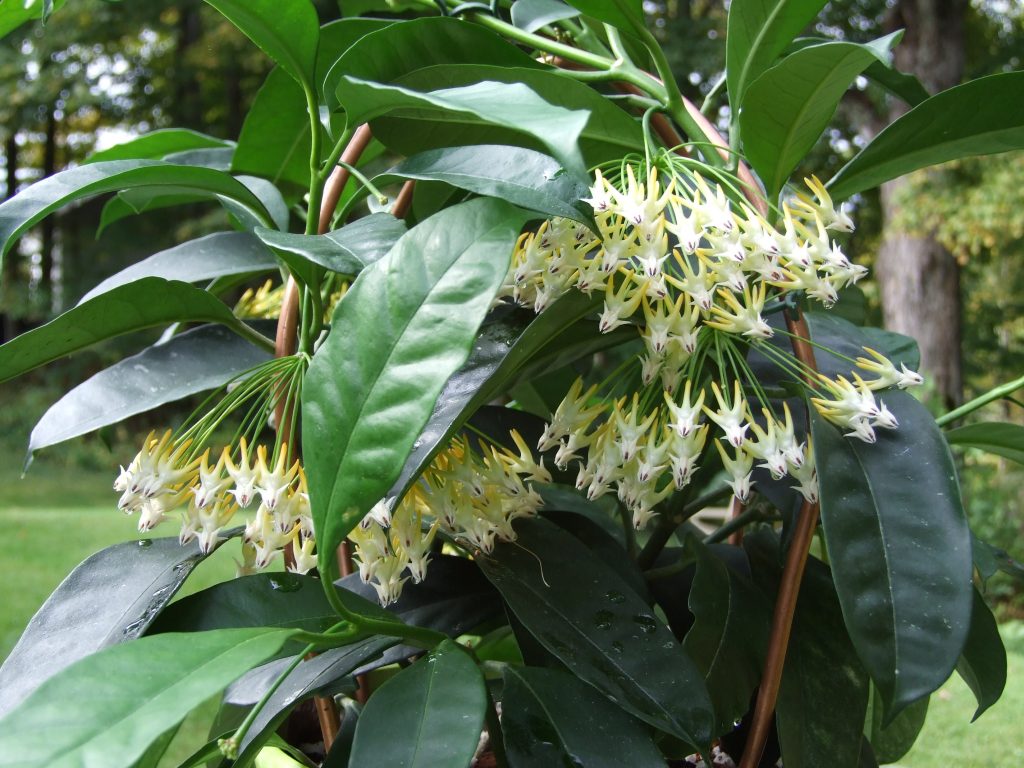Hoya Multiflora - care features
Hoya Multiflora is an abundantly flowering tropical plant from the Lastovnev family. Under natural conditions, it grows in Indonesia, Thailand, the Philippines. Its name is translated as "multi-flowered" and for good reason - the hoyka blooms willingly and for a long time, delighting with lush inflorescences and unusual flowers.

Hoya multiflora pruning
Description of the plant
Multiflora belongs to the bushy varieties of hoya. It can reach a height of 1 m or more. Usually its size and splendor is controlled by trimming. Hoyka has rather thick stems, which lignify over time (diameter - 0.5-0.7 cm).
The leaves are oblong, with a pointed tip, up to 10-12 cm long. In the classic variety they are emerald green, in the variegated one they are spotted.
Small flowers are collected in umbellate inflorescences of 15-25 pieces. The petals are sharp, white-yellow, curved back. The crown is a little white with a lilac-pink center.
The original shape of the flower resembles a rocket, arrow or frozen jellyfish rushing upward.
Flowering occurs in the warm season and lasts up to two weeks, and then it repeats (with good care, this hoyka can bloom all year round).
Purchase and adaptation
Hoya Multiflora is rarely found in flower shops. However, it can be found and bought via the Internet: a rooted specimen or a cut cut. Better to arrange a personal meeting or ask for detailed photos of the plant before shipment. It should be free of damage, foreign stains, dry and faded sheets.

Hoya multiflora
This hoyka does not like to change her place of residence. Changing conditions for her is real stress. In order not to aggravate the problem, try not to rearrange the flowerpot once again, not to cut off the Multiflora and not to transplant.
The flower needs diffused lighting or light partial shade, warmth (20-24 ° C) and moderate watering as the top layer of the soil dries up. For the first two to three weeks, keep your hoya apart from other house flowers until you are sure it is completely healthy.
Landing rules
Hoya likes light, neutral, well-drained soil. It can be grown in a soil mixture of leaf or coniferous soil, peat, vermiculite, pieces of tree bark. From purchased substrates, a composition for orchids or succulents is suitable.
Technology:
- Disinfect the self-prepared substrate (ignite or freeze, soak the bark in boiling water and dry).
- Put drainage on the bottom of the pot (small pebbles, perlite, broken brick).
- Take the hoyka out of the old container and carefully transfer it without breaking the coma.
- Install a support for Multiflora stems in the flowerpot.
- Pour the substrate into the free spaces between the flower and the walls, compact well.
- Drizzle with warm (but not hot) settled water.
The necessary conditions
Multiflora loves moisture, warmth and good lighting. However, a measure is needed in everything: waterlogging can lead to rotting of the roots, and direct sunlight can lead to burns.

Hoya multiflora photo
The optimum temperature is from 20 ° C to 25 ° C. Even with slight cold snaps, it begins to shed leaves, buds and flower stalks.
The plant needs regular spraying with lukewarm soft water, as well as shower procedures. The room must be frequently ventilated, avoiding drafts.
The flower grows well in diffused lighting with shading in the midday heat. In winter, it can be artificially illuminated.
Care
Caring for Multiflora is not particularly difficult. Hoya needs the correct watering regime, feeding and shaping.
During flowering, it is advisable not to disturb it once again (do not turn, cut off, do not change the location) and do not allow water or fertilizers to get on the flowers.
Watering
The roots of Multiflora should be in a moist substrate, but not in a swamp of stagnant water.
Hoya is watered regularly 1-2 times a week, focusing on the topsoil (it must dry out by the time of the next procedure). For watering, use soft water at room temperature. If moisture remains in the pan, it must be drained.
Top dressing
During flowering, hoya needs to be fed with universal compounds for orchids and succulents. Top dressing is carried out 1-2 times a month. The dose of the substance prescribed on the package is halved by dissolving in the specified amount of water. The solution is applied immediately after watering into a well-moistened soil.

Hoya multiflora home care
Transfer
Multiflora has a compact root system, so adult plants are rarely transplanted. (Young, actively growing Hoykes are transplanted annually).
If the roots still fit in the pot and do not stick out of the drainage holes, you can simply change the top layer of the substrate without transferring the flower to another container.
Pruning
Pruning is carried out at the end of flowering, controlling the size and splendor of the plant. Cut off only the top of the main stem, without touching the short shoots (flowers usually form on them).
The procedure is indicated not only for slowing growth - after it the hoya begins to bush more actively.
Important: you cannot cut off dry peduncles, otherwise in the next season you can not wait for flowers.
Propagation by cuttings
Multiflora propagates by cuttings (sowing seeds and rooting with leaves rarely produce the desired results). Last year's shoots (not lignified) with two nodes are cut from the bush.

Hoya multiflora variegated
The lower leaves are removed, and the cut is treated with a rooting stimulator.
The cuttings are rooted in water or in a moist substrate. (In the first case, you need to take a dark container or wrap the glass in foil so that the light does not hit the roots).
From above, the plants are covered with plastic cups or a plastic bag to maintain the greenhouse temperature (22-24 ° C). The greenhouse is regularly ventilated, and the soil mixture is moistened.
When the small hoya grows new leaves, it can be transplanted to a permanent place.
Diseases and pests
| Problem | Symptoms | Prophylaxis | Treatment |
| Shield | Insects in the form of dark brown tubercles. | Spraying with clean warm water, frequent showers, regular airing of the room, quarantine for newly arrived plants. | Wash the hoya with tar soap. Remove plaques with a soft brush. If pests are not removed, treat with Fitoverm. |
| Aphid | Small bugs of light green color. Curling, deformation and drying of leaves. | Remove affected leaves, wash the plant with soapy water. In case of a strong invasion, use insecticides (Intavir, Fas, Karate). | |
| Whitefly | The appearance of larvae and white insects with wings. Shiny bloom on the leaves and sooty mushroom. | Wash the hoya with soap and alcohol. Hang up sticky traps to catch flying pests, and collect the caterpillars by hand. Change the top layer of earth in the flowerpot. In serious cases, use Actellic or Confidor. | |
| Root and stem rot | Stopping growth.Dark softened areas appear on the stems. The leaves wither and fall off. | Avoid waterlogging. Disinfect the flowerpot, drainage materials, tools. | Cut off the damaged parts of the hoya and treat with an antiseptic. Spray with fungicide (Trichodermin, Mikosan, Topaz). Transplant Multiflora into a new substrate. |

